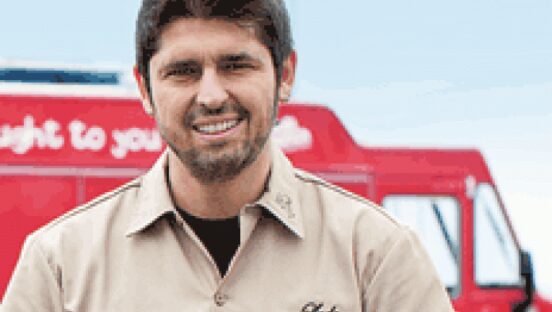The acclaim for chef Ludo Lefebvre is vast: Classically trained in his homeland of France, Lefebvre studied under some of that country’s best chefs before moving to Los Angeles in 1996. After his move to the U.S., Lefebvre was the head chef of a top-rated L.A. restaurant by the age of 25; helped two restaurants become Mobil Five Star–rated; was nominated for the James Beard Rising Chef Award; and appeared on both Top Chef Masters and Iron Chef.
So it seemed only natural that the chef would want to open … a food truck?
“It’s definitely another challenge for me, but food is food—why not cook good food on the street?” Lefebvre says. “What really excites me is to cook for the masses, to cook for everybody with a truck.”
LudoTruck, Lefebvre’s venture into the food truck world that was supported by food truck consultant Mobi Munch, soft launched in June before hitting the streets regularly in August. The truck is part of a grander strategy from the French chef: Growing his “pop-up restaurant” concept LudoBites, which operates only for a short time in various locations.
But Lefebvre’s new vehicle is also part of a bigger food truck trend that is turning the entire foodservice industry on its head. Fine-dining and quick-service concepts alike are adapting to the fact that good food can arrive on four wheels, and increasingly, the general public is embracing it.
Taking Off
Having lived in France until he was 24, Lefebvre didn’t exactly grow up surrounded by street food.
“In France, you can eat a sandwich on the street; you go to the bakery and you buy a sandwich,” he says. “Or you have some crêpes. But that’s it in France. So I was really introduced to street food more here in America with the food truck.”
The fact that Lefebvre moved to Los Angeles, the capital of American street food if ever there was one, didn’t just introduce Lefebvre to the food truck scene—it threw him into the fire. More than 100 trucks cruise the streets of L.A., dishing out everything from tacos to banh mi to grilled cheese.
Lefebvre says he didn’t invest too much in the thoughts of opening his own truck until this year, when he was invited to take his LudoBites pop-up concept to February’s L.A. Street Food Fest. It was there that Mobi Munch offered to sponsor him, and the wheels just started to spin.
“When Mobi Munch approached me to do the truck, I thought, ‘Why not?’” Lefebvre says. “I can bring gastronomic food to the streets.”
It didn’t hurt that Lefebvre had already seen skilled chefs successfully take their culinary expertise on the road.
“I really admire Roy Choi,” he says, referring to the chef behind Los Angeles–based Kogi BBQ, one of the best-known players in the food truck business. “He was really the first chef to … put good food on the street.”
The rise of “celebrity” food trucks is not lost on Mobi Munch, an upstart food truck business that provides operators with the infrastructure necessary to get their trucks up and running. Ray Villaman, the cofounder and president of the company who was once executive director of the California Restaurant Association and has worked with national quick-service chains such as Boston Market, started the company with fellow food businessmen Josh Tang and Aaron Noveshen in 2009.
Villaman says “high-visibility chefs” are the perfect match for creating popular food truck brands. In Lefebvre, the Mobi Munch team saw the perfect opportunity to get its project into the public eye fast.
“He saw the space of mobile gourmet food fit along the lines of what his goals were,” Villaman says, “which was getting his food out to the masses in a convenient, mobile, flexible manner. So we decided to partner with him. We run the truck; he does the food.”
The process of transitioning Lefebvre’s skills and experience into a truck-based concept took about five months. From the beginning, though, there was never a question about what food would be served out the truck window. And it had nothing to do with Levebvre’s French culinary background.
“At that time I was looking to do a fried chicken concept,” Lefebvre says. “At Ludo Bites, I started to work on some preparation with fried chicken. The first one I did was a fried chicken on the bone fried in duck fat. We evolved the dish into a street-friendly version with no bone, always thinking how to make it easy to eat for people in the street.”
Lefebvre says his chicken is “hand food,” essentially a chicken nugget that is brined, dipped in buttermilk and flour, then tossed in spices before hitting the fryer.
He adds that just because it’s fried chicken from a truck doesn’t mean it’s low in quality. Using his fine-dining expertise and combining it with what he says are “fresh” and “natural” ingredients, Lefebvre says LudoTruck ultimately provides the same kind of top-notch experience that a sit-down restaurant might.
“You know the thing is, on the truck, I’m cooking fried chicken, but I’m still using the same technique I do at the restaurant,” he says. “All of the best techniques I learned in France with all of the best chefs. I don’t jeopardize on the quality.”
The beauty of LudoTruck, Lefebvre says, is that it accomplishes both of his goals of quality and reaching the masses. And it’s delivered in a format that can stretch the entire city of Los Angeles.
“Now I reach a different customer: foodies, people who don’t have too much money but want good food, people who have a lot of money but still want to come to the truck because of our fried chicken,” Lefebvre says. “It’s pretty amazing to just serve in the street and to put people together. That’s what food is.”
[pagebreak]
Easing In
A food truck is not a simple operation. “People don’t realize it’s like a restaurant,” Lefebvre says. “You need to rent a commissary kitchen, hire a staff, and prep the staff. It’s the same headache of the restaurant. It’s not easy.”
New challenges presented themselves with LudoTruck that Levebvre never experienced in a restaurant. One example is the need to scale his recipe to serve a much larger volume of people. Then there was the issue of supply.
“At the restaurant, you have a big walk-in; you can always go and get some more vegetables,” Lefebvre says. “Sometimes our commissary kitchen is far away, and sometimes we’re going to run out of food. There’s nothing we can do. That’s one of the problems, because sometimes we get slammed.”
A burden facing the food truck movement, Villaman says, is that too many people believe they can buy a repossessed truck, throw an oven in it, and cart it around town at will. What Mobi Munch aims to do is organize the food truck movement and turn it into something with formidable selling power.
But Villaman says Mobi Munch isn’t just looking to invest in a couple of food trucks—it wants to help shape the entire movement.
“In conjunction with partnering with … high-visibility chefs and being their operations arm, we compliment them with our website, which is directed toward all of the mobile food truck industry,” he says of the company’s MobileCravings.com, which he calls the “Facebook of mobile food.”
In fact, there are three arms to Mobi Munch’s business model. One is the online promotion of the movement as a whole. The second is owning and operating its own food trucks, including the Chairman Bao Bun Truck in San Francisco.
The third arm of Mobi Munch is the development of trucks for independent operators and chains. Villaman says at least four national quick-service chains have been in contact with the company about moving beyond brick-and-mortar stores.
Part of the consulting Mobi Munch does with food trucks is helping them understand the rules of the game, and how to coexist with traditional restaurants.
“We’re part of a mobile truck and vendors association and we’re trying to use that as a vehicle to start educating people, saying, ‘Look, let’s play by agreed upon rules with the brick-and-mortar restaurants or else we’re going to keep butting heads,” Villaman says.
“Once those rules are laid out in the different municipalities across the country, you’re going to see more sophisticated operators enter the space.”
As a man who has worked in several brick-and-mortar stores himself, Lefebvre adamantly supports staying away from any small operator his truck might affect.
His ideal squatting spot? An office park.
“You know, people don’t have too much time to eat,” he says. “Life is changing. American people work so hard. With the trucks, it gives an opportunity to people who walk out of the office and have 20 minutes or 30 minutes to eat to go down the street to eat the fresh food from a truck.”
The ultimate goal for Mobi Munch is to do to the food truck world what Ray Kroc did to the fast food world.
“The best-in-class trucks will scale to four or five trucks,” Villaman says. “It’s no different with brick and mortar; once an operator gets into four or five units, they need someone else to take them from five to 50 or five to 100. That’s our group.”
Villaman foresees taking the LudoTruck brand nationwide. “We partnered with Ludo to have 10, 20, 50 trucks, not just the one,” he says. While Lefebvre says he’s still in a wait-and-see mode with LudoTruck, he knows what opportunities extend across the U.S.
“I use a lot of Twitter, and I have a lot of people from the East Coast who want to try my chicken too, or Chicago or San Francisco,” Lefebvre says. “Why not one day do our truck in a different city?”
Speeding Away
Food trucks are hardly a product of the 21st century. Taco trucks and roach coaches have been taking food to the streets for decades. But the latest movement might just be the one to make food trucks a foodservice equal to brick-and-mortar establishments, experts say.
Melissa Abbott, director of culinary insights and trends for market research firm The Hartman Group, says the food truck movement is rising in popularity because consumers are looking for quality food, and that’s what trucks are finally producing.
“Whoever typically is behind the food truck, they’re really doing it with super fresh ingredients, super local ingredients, and their recipes are much more authentic than something you might get at a restaurant for the same price,” she says.
In addition to quality food, Lefebvre says trucks also offer a vast array of meal options.
“You can try so many different things,” he says. “Unfortunately, in America, we all work so much, and our schedules don’t allow us to sit down to a proper lunch. The truck can provide you great, quality options.”
The options in food trucks are so vast, in fact, that The Hartman Group is no longer limiting its menu innovations research to mom and pop establishments.
“Now we’re looking at the food trucks,” she says. “Because from the food trucks, then it works its way to quick-serve restaurants and fast casual, and then it works itself into consumer packaged goods.”
While Abbott says the food truck movement is being fueled by Millennials who are also bringing along their Baby Boomer parents, Villaman thinks the space has a way to go before it’s fully accepted by the general public.
“Today, it’s the foodies that are all over the food truck space, not the general public,” he says. “What happens after the foodies embrace you is they tell their friends, and then the masses become more inclined to support it.
“So we feel it’s only a matter of time until the public is embracing street food and mobile food in the same way it embraces brick and mortar.”












